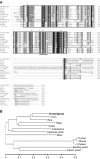Characterization of orchardgrass p23, a flowering plant Hsp90 cohort protein
- PMID: 18800239
- PMCID: PMC2728258
- DOI: 10.1007/s12192-008-0077-6
Characterization of orchardgrass p23, a flowering plant Hsp90 cohort protein
Abstract
p23 is a heat shock protein 90 (Hsp90) co-chaperone and stabilizes the Hsp90 heterocomplex in mammals and yeast. In this study, we isolated a complementary DNA (cDNA) encoding p23 from orchardgrass (Dgp23) and characterized its functional roles under conditions of thermal stress. Dgp23 is a 911 bp cDNA with an open reading frame predicted to encode a 180 amino acid protein. Northern analysis showed that expression of Dgp23 transcripts was heat inducible. Dgp23 has a well-conserved p23 domain and interacted with an orchardgrass Hsp90 homolog in vivo, like mammalian and yeast p23 homologs. Recombinant Dgp23 is a small acidic protein with a molecular mass of approximately 27 kDa and pI 4.3. Dgp23 was also shown to function as a chaperone protein by suppression of malate dehydrogenase thermal aggregation. Differential scanning calorimetry thermograms indicated that Dgp23 is a heat-stable protein, capable of increasing the T (m) of lysozyme. Moreover, overexpression of Dgp23 in a yeast p23 homolog deletion strain, Deltasba1, increased cell viability. These results suggest that Dgp23 plays a role in thermal stress-tolerance and functions as a co-chaperone of Hsp90 and as a chaperone.
Figures







Similar articles
-
Functional characterization of orchardgrass endoplasmic reticulum-resident Hsp90 (DgHsp90) as a chaperone and an ATPase.Plant Physiol Biochem. 2009 Oct;47(10):859-66. doi: 10.1016/j.plaphy.2009.06.008. Epub 2009 Jun 30. Plant Physiol Biochem. 2009. PMID: 19625192
-
Orchardgrass ACTIVATOR OF HSP90 ATPASE possesses autonomous chaperone properties and activates Hsp90 transcription to enhance thermotolerance.Biochem Biophys Res Commun. 2022 Jan 1;586:171-176. doi: 10.1016/j.bbrc.2021.11.080. Epub 2021 Nov 24. Biochem Biophys Res Commun. 2022. PMID: 34856417
-
Characterization of a plant homolog of hop, a cochaperone of hsp90.Plant Physiol. 2003 Feb;131(2):525-35. doi: 10.1104/pp.011940. Plant Physiol. 2003. PMID: 12586877 Free PMC article.
-
p23 and Aha1: Distinct Functions Promote Client Maturation.Subcell Biochem. 2023;101:159-187. doi: 10.1007/978-3-031-14740-1_6. Subcell Biochem. 2023. PMID: 36520307 Review.
-
Protozoan HSP90-heterocomplex: molecular interaction network and biological significance.Curr Protein Pept Sci. 2014 May;15(3):245-55. doi: 10.2174/1389203715666140331114233. Curr Protein Pept Sci. 2014. PMID: 24694366 Review.
Cited by
-
RBM14 enhances transcriptional activity of p23 regulating CXCL1 expression to induce lung cancer metastasis.Acta Pharm Sin B. 2025 Jun;15(6):3059-3072. doi: 10.1016/j.apsb.2025.03.048. Epub 2025 Apr 4. Acta Pharm Sin B. 2025. PMID: 40654360 Free PMC article.
-
Structural elements in the flexible tail of the co-chaperone p23 coordinate client binding and progression of the Hsp90 chaperone cycle.Nat Commun. 2021 Feb 5;12(1):828. doi: 10.1038/s41467-021-21063-0. Nat Commun. 2021. PMID: 33547294 Free PMC article.
-
Interplay of p23 with FKBP51 and their chaperone complex in regulating tau aggregation.Nat Commun. 2025 Jan 14;16(1):669. doi: 10.1038/s41467-025-56028-0. Nat Commun. 2025. PMID: 39809798 Free PMC article.
-
Heat shock proteins in association with heat tolerance in grasses.Int J Proteomics. 2011;2011:529648. doi: 10.1155/2011/529648. Epub 2011 Feb 24. Int J Proteomics. 2011. PMID: 22084689 Free PMC article.
-
A novel thiol-reductase activity of Arabidopsis YUC6 confers drought tolerance independently of auxin biosynthesis.Nat Commun. 2015 Aug 28;6:8041. doi: 10.1038/ncomms9041. Nat Commun. 2015. PMID: 26314500 Free PMC article.
References
Publication types
MeSH terms
Substances
LinkOut - more resources
Full Text Sources
Molecular Biology Databases
Research Materials
Miscellaneous

